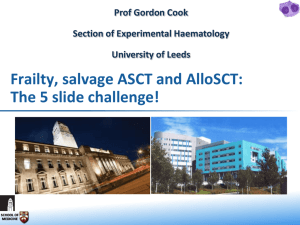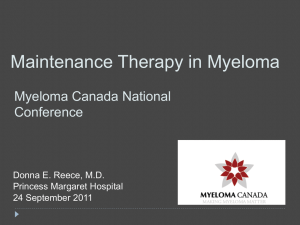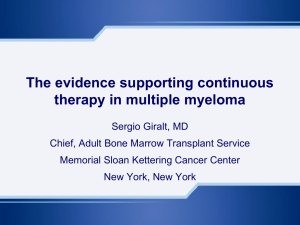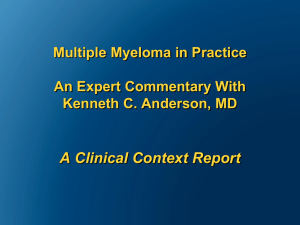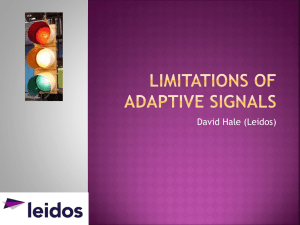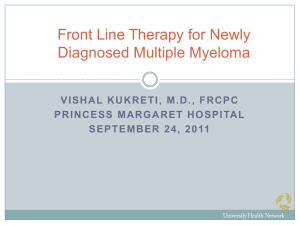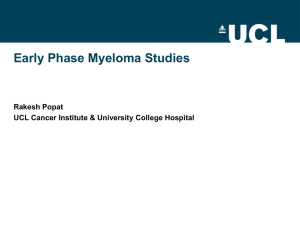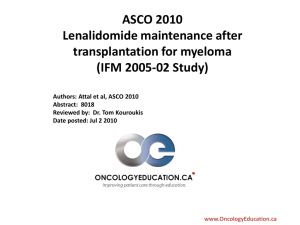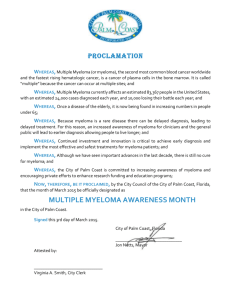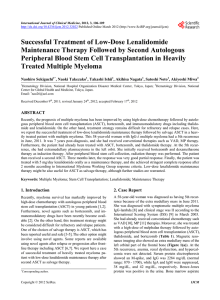ASH 2015 Review — Dr Guy Pratt
advertisement
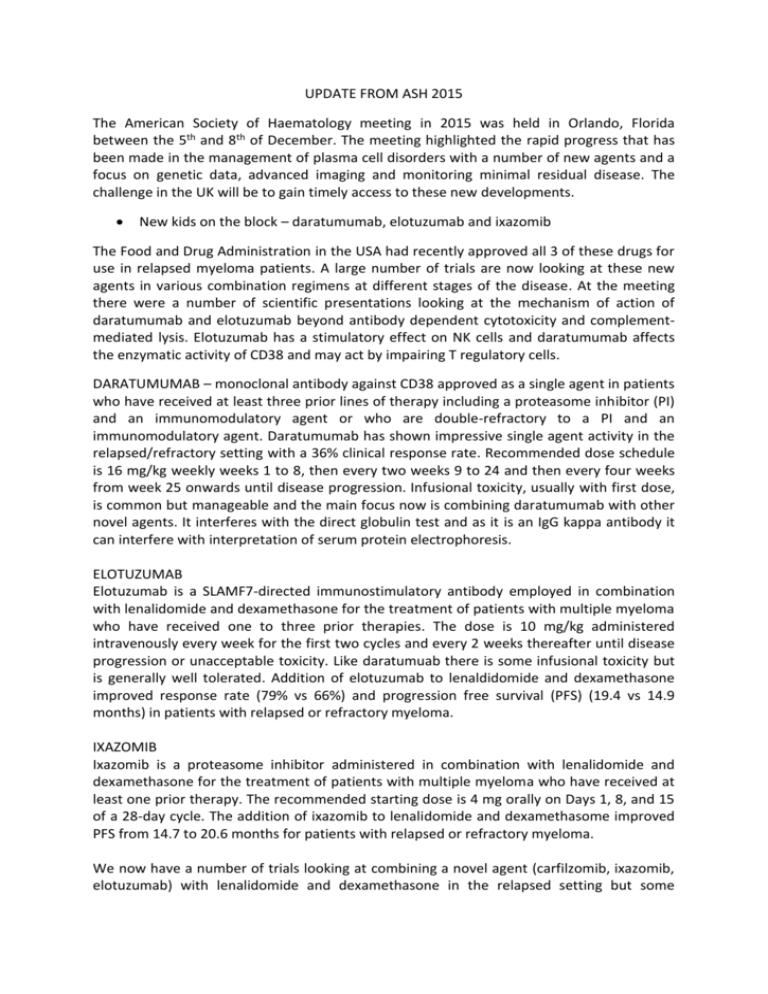
UPDATE FROM ASH 2015 The American Society of Haematology meeting in 2015 was held in Orlando, Florida between the 5th and 8th of December. The meeting highlighted the rapid progress that has been made in the management of plasma cell disorders with a number of new agents and a focus on genetic data, advanced imaging and monitoring minimal residual disease. The challenge in the UK will be to gain timely access to these new developments. New kids on the block – daratumumab, elotuzumab and ixazomib The Food and Drug Administration in the USA had recently approved all 3 of these drugs for use in relapsed myeloma patients. A large number of trials are now looking at these new agents in various combination regimens at different stages of the disease. At the meeting there were a number of scientific presentations looking at the mechanism of action of daratumumab and elotuzumab beyond antibody dependent cytotoxicity and complementmediated lysis. Elotuzumab has a stimulatory effect on NK cells and daratumumab affects the enzymatic activity of CD38 and may act by impairing T regulatory cells. DARATUMUMAB – monoclonal antibody against CD38 approved as a single agent in patients who have received at least three prior lines of therapy including a proteasome inhibitor (PI) and an immunomodulatory agent or who are double-refractory to a PI and an immunomodulatory agent. Daratumumab has shown impressive single agent activity in the relapsed/refractory setting with a 36% clinical response rate. Recommended dose schedule is 16 mg/kg weekly weeks 1 to 8, then every two weeks 9 to 24 and then every four weeks from week 25 onwards until disease progression. Infusional toxicity, usually with first dose, is common but manageable and the main focus now is combining daratumumab with other novel agents. It interferes with the direct globulin test and as it is an IgG kappa antibody it can interfere with interpretation of serum protein electrophoresis. ELOTUZUMAB Elotuzumab is a SLAMF7-directed immunostimulatory antibody employed in combination with lenalidomide and dexamethasone for the treatment of patients with multiple myeloma who have received one to three prior therapies. The dose is 10 mg/kg administered intravenously every week for the first two cycles and every 2 weeks thereafter until disease progression or unacceptable toxicity. Like daratumuab there is some infusional toxicity but is generally well tolerated. Addition of elotuzumab to lenaldidomide and dexamethasone improved response rate (79% vs 66%) and progression free survival (PFS) (19.4 vs 14.9 months) in patients with relapsed or refractory myeloma. IXAZOMIB Ixazomib is a proteasome inhibitor administered in combination with lenalidomide and dexamethasone for the treatment of patients with multiple myeloma who have received at least one prior therapy. The recommended starting dose is 4 mg orally on Days 1, 8, and 15 of a 28-day cycle. The addition of ixazomib to lenalidomide and dexamethasome improved PFS from 14.7 to 20.6 months for patients with relapsed or refractory myeloma. We now have a number of trials looking at combining a novel agent (carfilzomib, ixazomib, elotuzumab) with lenalidomide and dexamethasone in the relapsed setting but some caution is needed in interpretation, as they are not directly comparable, as illustrated by the differences in the outcomes for the control arm (lenalidomide and dexamethasone). For example, the PFS in the control arm in the ASPIRE trial is superior to that seen in the trials with ixazomib and elotuzumab; this is likely due to differences in the study population and the inclusion/exclusion criteria. Which proteasome inhibitor: Carfilzomib vs Bortezomib? Data was presented from the ENDEAVOR trial (published in Lancet Oncology in Dec 2015 Dimopoulos et al), a phase 3 trial comparing carfilzomib with bortezomib, both in combination with dexamethasone, in patients with relapsed or refractory multiple myeloma. There was a significant improvement in PFS with carfilzomib- dexamethasone of 18.7 months compared to 9.4 months with bortezomib-dexamethasone although it is too early to see a survival benefit. Presentations at ASH suggested that the improvement was seen irrespective of age and also benefited the high risk cytogenetic group although high risk patients still did worse than non-high risk patients. Autologous stem cell transplantation remains a standard of care at diagnosis for patients suitable for the procedure The IFM/DFCI 2009 study was present by Michel Attal. This study compared an upfront ASCT following RVD induction compared to a delayed ASCT as follows – RVD x 3, standard ASCT, RVD x 2 consolidation followed by lenalidomide for 12 months versus RVD x 8 (stem cell harvest after 3 RVD) followed by lenalidomide for 12 months (with ASCT planned at relapse) This study addressed the important question of the role of upfront ASCT in the era of novel agents and confirmed that ASCT remains the gold standard treatment for patients suitable for the procedure. The 3-year post-randomization PFS rate was 61% in the transplant arm versus 48% in the RVD arm. The PFS benefit observed in the transplant arm was uniform across all the following subgroups: age (≤ or > 60 years), sex, Ig isotype (IgG or others), ISS stage (I or II or III), cytogenetics (standard or high risk), and response after the 3 first cycles of RVD (complete response or not). ASCT should remain a standard of care for young patients with myeloma. Further follow-up is needed, as the number of deaths is still low in both arms. The parallel US trial, which uses a similar design is on-going –importantly the US study administers maintenance lenalidomide continuously until progression in both arms (unlike the IFM study which stopped after one year). Newer imaging techniques and bone marrow-based MRD: case for both In the IFM/DFCI 2009 study there was also a comparison of imaging techniques - MRI and PET imaging. There was no obvious differences between the two techniques at diagnosis in terms of sensitivity. However MRI was of no value for monitoring as few patients showed normalisation of their MRI scan. Normalization of PET-CT following 3 cycles of RVD and before maintenance was associated with a significant improvement for PFS. Normalization of PET-CT before maintenance was a predictor for an improved OS. MRD by bone marrow assessment did not correlate that well with PET indicating that to assess quality and depth of response in trials, both imaging by PET and bone marrow assessment will be required. Patients negative by both PET and MRD had clearly better outcomes Is an IMID+proteasome triplet the best induction therapy? A number of studies looked at an IMID + proteasome triplet combination upfront and showed increasing evidence that this may well be an optimal combination for patients. An important exception is likely to be the frail elderly where such a regimen may not be so well tolerated. Importantly a number of studies at various stages of the disease suggest that this combination may partly overcome some high risk features although further studies are needed Durie et al presented the SWOG trial of Bortezomib, Lenalidomide and Dexamethasone (VRd) Vs. Lenalidomide and Dexamethasone (Rd) in patients with newly diagnosed myeloma not intended for an ASCT in first line. 232 patients were randomized to Rd and 242 patients to VRd with all patients receiving Rd maintenance. The median PFS was 43 months for VRd versus 31 months for Rd and median OS was 75 months for VRd versus 63 months for Rd. The IFM group presented their data on a randomised trial of VTD (Bortezomib-thalidomidedexamethasone) vs VCD (Bortezomib-cyclophosphamide-dexamethasone) induction prior to an ASCT. The trial aimed to look at response rates (as subsequent treatments post induction varied so PFS/OS was not comparable). 170 were randomized each to VTD and VCD. The median number of induction cycles administered in both arms was 4. The overall response rate (>PR) was 92.3% with VTD, including a 10.7% complete response (CR) rate and a VGPR rate of 66.7%, while with VCD the overall response rate was 84%, with a 9.5% CR and a 56.2% VGPR rate. VGPR and PR rates were significantly higher in the VTD arm with p-values of 0.04 and 0.02, respectively. Preliminary data from Myeloma XI trial were presented for the KCRD arm (Carfilzomib, Cyclophosphamide, Lenalidomide, Dexamethasone) in patients suitable for intensive treatment. The regimen appears well tolerated (comparable to 3 drug regimens) with excellent response rates. VGPR or greater overall response rate was reported in 55% of patients randomised to CTD arm, 62% on CRD arm and 82% on KCRD arm respectively. T cell immunotherapy As well as monoclonal antibodies, T cell therapies are beginning to emerge as promising treatments in myeloma. PD-1 blockage with monoclonal antibodies has produced spectacular results in some solid tumours but showed disappointing activity as single agents in patients with myeloma. However encouraging results were presented showing that PD-1 blockade (in this case with pembrolizumab) in combination with lenalidomide and dexamethasone was both safe and showed some promising activity including patients previously refractory to lenalidomide. In the late breaking abstract session, a study using modified T cells (CAR T cells) designed to recognise BCMA on malignant plasma cells was presented. Although only small numbers of patients had been treated and follow up was short, there was clear activity of the infused CAR T cells. A severe rapid onset cytokine release syndrome was seen in some patients similar to that seen with patients treated with CD19 CAR T cell therapy. Salvage ASCT at first relapse Prof Gordon Cook presented an update of the Myeloma X data showing a significant survival benefit when salvage ASCT consolidates bortezomib-based reinduction therapy in patients with myeloma at first relapse (median survival 67 months for 2nd ASCT vs 52 months for non transplant consolidation). The delay of salvage ASCT to third line, though being suggestive of benefit over no salvage ASCT, does not confer the same degree of OS advantage as shown with a salvage transplant in second line. Minimal residual disease There is increasing interest in MRD as it clearly has strong prognostic value following therapy and there was much discussion at ASH. Flow cytometry and next generation sequencing are being used for assessment of marrow disease but as discussed above it is likely that PET imaging may be required in addition to these tests to increase the predictive value of MRD. The unanswered question that requires prospective randomised trials is whether the MRD result could be used to guide therapy and currently there is a lack of evidence to guide us. Antibiotic for amyloid Dr Wechalekar from the National Amyloid Centre in London presented data on 30 patients with stage III AL amyloidosis treated with the oral antibiotic doxycycline 100mg twice daily given indefinitely from the start of treatment. The addition of an antibiotic appears to improve survival compared to a matched retrospective cohort except for the group of patients with the most advanced IIIb disease. Further larger studies are needed to explore this and in particular how doxycycline improves survival is presently unclear.
